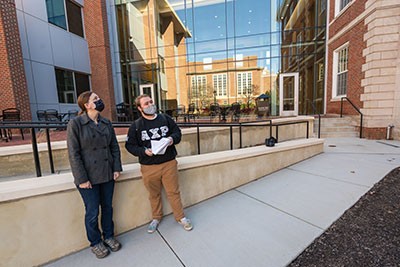
Radford University biology professor Karen Powers and dozens of her students have been busy researching an issue that is killing a billion birds each year in the United States.
“That’s billion, with a B,” Powers said.
It’s window collisions, the no.-2 cause of bird deaths in the county. To no one’s surprise, cats come in first.
Because Radford University and most college campuses are populated with a number of large buildings decorated with dozens of reflective windows, the problem is even more pronounced.
In 2020, Powers and her student researchers reported 72 individual birds that had died due to a collision. More than 140 birds have been recorded since the project began. Some might not see that number as significant, but Powers asks that people consider the problem on a larger scale.
“It has been published a lot recently that bird populations are down, in some places as much as a 75% decline in the number of individuals,” she said.
The research project began back in 2018 after a guest speaker of the student chapter of The Wildlife Society brought up the topic and explained the research efforts of a neighboring institution to address the problem.
“He was telling us all about the research and how easy it was, especially for students,” Powers said. “I thought it would be a neat project for our students to get involved in.”
That spring, Powers was willing to take on three to four research students “just to get our feet wet a little bit,” she said. Turns out, 18 signed up, and Powers couldn’t say no. So, she turned the research project into a one-credit class.
The team began by identifying 15 campus buildings that were representative of the variety of buildings on campus. The subset included tall buildings of varying heights, and they chose buildings surrounded by a lot of vegetation and also those with very little. Some buildings had lots of window area, and some had a lot less.
“It’s something that they could complete in between classes,” Powers said. “It worked out really well that students could work around their own schedules.”
Some students measured the window area of each building or looked for the presence of bird feeders and other objects that would attract birds. Others looked at whether the birds were migratory or resident.
Student project participants Justin McLaughlin, Trey Harris and Thomas Marshall come from different backgrounds. McLaughlin, a psychology and biology major, is a pre-med student. Harris, also a biology major, is interested in pursuing a career in wildlife rehabilitation. Marshall graduated from Radford over the Winter 2020 semester and is studying medical technology.
Despite their different personal and professional preferences, they share a special bond over birds.
“I’ve always been a big bird person. I even have two birds as pets back home,” McLaughlin said. “They are very meaningful and symbolic to me, and I think they’re such intelligent and beautiful creatures.”
Harris is an animal and outdoor enthusiast. The project, he said, aligned perfectly with his interests. A sophomore, Harris has been involved in the research since the summer of 2020.
All three men agreed the research rallied them through the Fall 2020 semester, which was filled with challenges.
“It was nice to put in a pair of headphones and head outdoors, especially after days of being cooped up. We could go outside, get some fresh air, enjoy nature and conduct really important research at the same time,” McLaughlin said.
Now in its third year, the project has yielded significant findings.
According to Powers, the biggest takeaway from the project so far is that buildings with more window area were the sites of more collisions.
Collisions are also more common among migratory birds and juvenile birds, birds that are not familiar with the territory or are confused by their reflection in the windows.
With these data, the team is now advancing toward a solution.
Powers and several students have met with university administrators to discuss the possibility of installing film on the windows attributed to the most collisions. “This is our first tangible output that I’m very excited about,” Powers said. “If the film gets installed, we now have before data and after data, so we could see if it’s really having an impact.”


